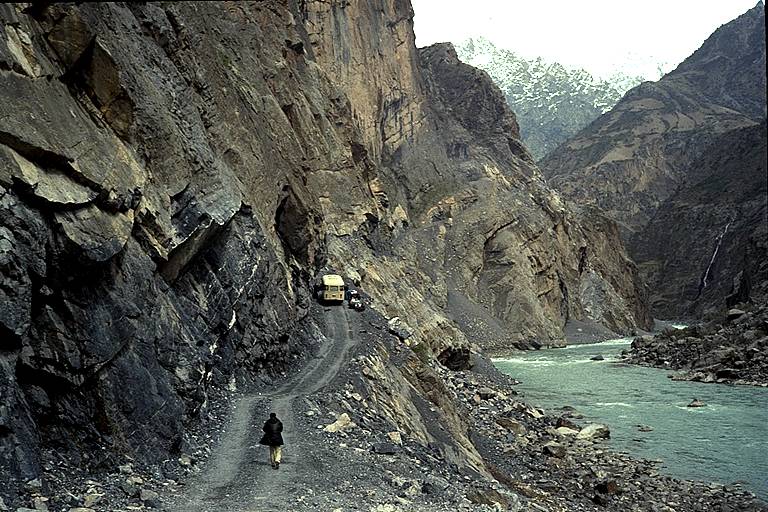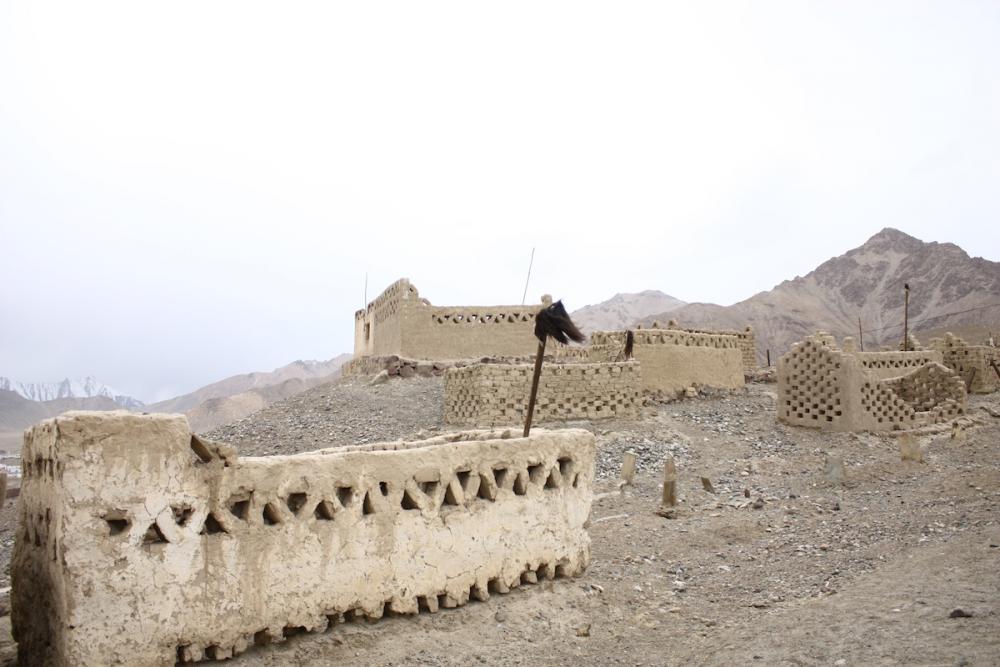
Just before dawn on July 24 of last year, the government of Tajikistan began a military operation in the small town of Khorog on the Afghanistan border. According to the government, the attack was targeted at four leaders of criminal groups involved in drug smuggling from Afghanistan, who were suspected of killing a local security official. It was the kind of operation the U.S. - worried about instability on Afghanistan's northern border - has been training and equipping Tajikistan's special forces units to carry out.
But to the people of Khorog, the operation looked very different. The scale of the attack - using helicopters, mortars, and the country's most elite soldiers - was clearly far beyond what was necessary to capture four men. Snipers on the mountains that rise steeply above the town shot at civilians. Phone and internet were cut off. One local civil society leader described huddling with his family in an interior room in his apartment; venturing to a window he saw the bodies of three neighbors - and a soldier's gun pointed at his window. "After that I understood: this wasn't between those leaders and the government, but between the government and the people," he recalled.
The operation backfired: Resistance from the town forced the government into a humiliating retreat after failing to capture any of the four men they had sought. And instead of exerting control, the government has alienated people here, who now nearly unanimously say they mistrust and fear the Dushanbe authorities. Groups of men patrol the streets at night, trying to prevent another surprise attack by the government. Men loyal to the leaders - commonly referred to as "commanders" - say they have gathered weapons in preparation for another war.
This comes at an unpropitious time for Tajikistan. In preparation for the withdrawal of U.S. and NATO troops from Afghanistan, scheduled to start next year, the U.S., Russia, and other partners have been trying to help Tajikistan's government bolster its shaky hold on the unstable country. Over the last several years, Dushanbe has managed to wrest control over most of Tajikistan from a variety of local warlords who still held sway as a legacy of the civil war that ravaged Tajikistan from 1992 to 1997. Khorog was to be the last step in that consolidation process. But the failure of last summer's operation, and the hardening of resistance among the people of Khorog, has instead reversed that momentum.
I spent two weeks in Khorog talking to a wide range of residents: civil society leaders, intellectuals, fighters, expats, and ordinary people. Almost none of them wanted their name published, fearing retribution from the government. I was unable to talk to government officials - exposing myself as a journalist (I was visiting on a tourist visa) would have exposed me to police scrutiny and possibly endangered my sources. But the picture that emerged from the town was clear: while news stories still generally refer to the local combatants as "militants," people consider the fight last year to have been a people's uprising in response to an attack on them by the government. And when the government comes back again (something that is widely believed to be inevitable both in Dushanbe and Khorog) the people here say they will form a front more united than before, and fight back harder than before.
Gorno Badakhshan - the region of which Khorog is the capital - is the most mountainous, remote part of an already very mountainous and remote country. Its geography is dominated by the Pamir (from Persian meaning "the roof of the world") Mountains, part of the same mountain system that includes the Himalayas and Hindu Kush. It is sparsely populated: Badakhshan's roughly 250,000 people represent 3 percent of Tajikistan's total population, but the territory occupies almost half of the entire country. The people, known as Pamiris, speak various Iranian languages that are related to, but not mutually comprehensible with, the Tajik spoken in the rest of Tajikistan. And where most of Tajikistan is Sunni Muslim, the Pamiris are Shia Ismailis, part of a worldwide community of 15 million loyal to the London-based Aga Khan.
For most of history, the Pamirs were profoundly isolated, but came under control of the Russian empire in 1905. In 1925, the Soviet Union formally created the Gorno Badakhshan Autonomous Oblast and, mindful of its strategic importance near the sensitive borders with China and Afghanistan, took pains to develop the area and strengthen their hold on it. They built a "highway" and established pharmaceutical and textile factories there.
Soon after independence came in 1991, the country fractured on regional lines and Tajikistan broke out in a civil war. The Pamiris eventually lost, but as part of the peace deal that ended the war the Pamiris' military leaders were given government positions. One, Mamadbokir Mamadbokirov, headed the border post with China and another, Tolib Ayombekov, a post on the Afghanistan border.
Since then, the government in Dushanbe has for the most part neglected the Pamirs. The factories closed, and the role of developing the economy was taken up by the Aga Khan Development Network, the aid group funded by the Pamiris' spiritual leaders. Pretty much anything that has been built in Badakhshan in the last 20 years has been the product of AKDN largesse, and the group is the region's largest employer. Politically, the Pamirs were quiet. In a 2008 Wikileaked U.S. diplomatic cable entitled "The Pamirs - Going Their Own Way, Whether They Want To Or Not," American embassy visitors to Khorog nevertheless found that "all our contacts dismissed regional alienation from Dushanbe as a non-issue." Still, after the government undertook operations to regain control in other parts of the country it was widely assumed that they would try to do the same in Badakhshan.
On July 21, Abdullo Nazarov, a local head of the State Committee for National Security (known by its Russian initials GKNB, the successor agency to the KGB) was killed in a dispute over a shipment of contraband cigarettes that had come through Ayombekov's border post. According to a local source who followed the case, Ayombekov's brother attempted to scare Nazarov by shooting at him, but he accidentally hit and killed him.
This proved to be the pretext the government was looking for. At the time, there were already a large number of soldiers in Badakhshan for a military exercise. Immediately following Nazarov's killing soldiers began to gather in Khorog, along with units from the Ministry of the Interior, GKNB, and National Guard. On July 23, about 100 residents of Khorog held a protest asking the soldiers to leave the town.
At 4 the next morning, residents awoke to the sound of gunfire. During the night, snipers had climbed up and taken positions on the steep mountains that enclose Khorog. While the exact order of events remains murky, what seems to have happened is that government soldiers initially focused their fire on the homes of the "commanders." But they faced unexpectedly strong resistance from fighters loyal to the commanders, and in response began to target civilians as well, which in turn prompted ordinary residents to take up whatever arms they had or could find.
As a result, the distinction between "fighters" and "civilians" became blurry. Nevertheless, according to local human rights groups who have tabulated the casualties, the majority of the dead and injured were unarmed people. One 16-year-old boy was killed by sniper fire while on his way to the family's outdoor toilet, his father said. A 66-year-old was shot and killed while looking out his window. In total, residents say about 20 civilians were killed, and three or four fighters loyal to the commanders.
The number of civilians killed is smaller than initial reports suggested, and one unusual thing about this uprising is that instead of presenting themselves as victims, the people of Khorog crow about their victory over the government. Asked how many people in town were killed, nearly everyone cites the figure of about 25. But asked about government casualties, residents often cite figures of 200 or 300 soldiers killed. (The real figure has been kept quiet by the government, but is believed to be a few dozen.) I heard unverified stories of military trucks filled with bodies retreating to their base dripping with blood. Or of Tajikistan special forces troops privately admitting that the Pamiris beat them soundly.
The forces that carried out the operation had received substantial training and equipping from the U.S. American officials rarely comment on security cooperation with Tajikistan, but according to what information is available, the U.S. had budgeted $9 million for aid to Tajikistan's various special forces units in 2012, part of a $24 million counter-narcotics aid package. One U.S. diplomatic cable from 2010 said that officers from U.S. Special Operations Command Central were planning an assessment of Tajikistan's special forces and then would be "organizing these groups into special units" and then "sustain an increase in capabilities" via training with U.S. special forces. U.S. aid has included rifles for the GKNB.
"What happened in Khorog is probably the tip of the iceberg as far as the GKNB's use of violence against political opponents and apparent involvement in criminal activities," said Susan Corke, director of Eurasia Programs at Freedom House. "The GKNB is a notoriously corrupt and repressive institution, allegedly involved in drug smuggling and openly engaged in repression of legitimate political dissent."
It's not clear how significant the U.S. role's in training Tajikistan's special forces was. There is no evidence that the U.S. supported, condoned or even was aware of the attack before it happened. But the U.S. has been put in an awkward position by the operation, and it has neither touted the operation as a success nor condemned it as an overreach. And despite laws that prohibit U.S. training of units that have committed human rights violations, the U.S. has continued its training programs with Tajikistan's forces. "The United States regularly reviews the full range of our bilateral aid programs to Tajikistan, including our security assistance," said Emily Horne, a State Department spokeswoman. "As with all countries, this ongoing review is part of our efforts to ensure our assistance dollars are being appropriately and effectively used. Because such reviews are ongoing, I'm not going to speculate on possible next steps."
One international official in Dushanbe said Tajikistan felt "emboldened" by U.S. military aid to carry out the operation. "If the U.S. gives money to our army and law enforcement agencies, they need to control where these funds go," said Manuchehr Kholiqnazarov, a human rights lawyer in Khorog. "The Americans should ask why their money is being used to attack civilians instead of attacking terrorists and drug traffickers." But a fighter loyal to one of the commanders joked to me: "You didn't train them very well."
After 17 hours of fighting, a ceasefire was negotiated with the help of the AKDN, but soldiers remained in Khorog. A month later, another local commander was killed under mysterious circumstances, and thousands protested, demanding that the government troops leave, which they did. In the operation's aftermath, the government tried to tie the events to Afghanistan, claiming that security forces had arrested eight Afghan citizens during the operation and that after Nazarov's murder Ayombekov had appealed to fighters in Afghanistan for support. No conclusive evidence, however, has emerged tying anything that happened in Khorog to Afghanistan (and the government seems to have dropped those talking points).
While Nazarov's killing was the pretext for the operation, no one - either supporters or critics - believe it was the real reason. Instead, the broad consensus is that the central government in Dushanbe felt that the "commanders" had become a little too autonomous and needed to be reined in. In particular, command of international trade routes through Badakhshan was likely a factor. The line between legal and illicit trade is blurry in Tajikistan, as even trade that passes through legal border points is deeply corrupt. Nazarov's killing may have been a pretext, but its circumstances - in a dispute over an illegal shipment of cigarettes through a border crossing controlled by a "commander" - is nevertheless emblematic.
Aside from small-time cigarette smuggling, Tajikistan's only border crossing with China is in Badakhshan, and since it opened in 2004 trade with China has become increasingly important to Tajikistan. China is now Tajikistan's largest trading partner, representing about $2 billion a year, roughly a third of the country's total commerce. That business is threatened by incomplete control of the Tajikistan-China border.
The operation also appeared to target Tajikistan's legitimate political opposition. The day before the attack, the regional leader of the Islamic Renaissance Party, Sabzali Mamadrizoyev, went missing. His body was found three days later, and a widely circulated YouTube video purports to show government soldiers dragging and kicking Mamadrizoyev's body. And the day of the operation, the party's Khorog head, Sherik Karamkhudoyev, was arrested and later sentenced to 14 years in prison on various charges that many see as trumped up.
Spending time in Khorog, it quickly becomes clear that the "commanders" enjoy broad support from most of the population. This was not necessarily the case before last summer's operation. Like many mafias, they supported locals against a predatory government. (For example, beating up two central government officials who had tried to extort money from a local gasoline dealer.) But they also were rough men involved in drug trafficking and other sorts of smuggling.
But the operation changed people's perception. "I don't like them. I respected them for their resistance [in the civil war] but personally I didn't like them," said one Khorog resident. "But the events of last year brought people together and created this sentiment of unity. All of a sudden we felt how vulnerable and unprotected we were." Another man who also had opposed the commanders said that once the fighting started, "I didn't think twice about which side I was on, these were invaders."
The consensus both in Dushanbe and Khorog is that the government will eventually try to finish what it started. Most think that another operation won't happen this year; presidential elections are scheduled for this fall and Rahmon is unlikely to want to do something with such unpredictable, possibly destabilizing, results before then.
Groups of men organized by neighborhood patrol Khorog's streets at night - "so they can't come and take people out of their houses in the middle of the night," one of the patrol's organizers told me. One man loyal to one of the commanders said that they had already been gathering guns and that the government couldn't be trusted. "If they know we don't have weapons they can do anything they want to us." (He acknowledged that that some in Khorog disagree with that strategy, thinking that people should do whatever possible to avoid provoking another attack.)
One civil society leader noted that last summer, many young people fled to the countryside when the attacks began. "If this happens again, though, they won't leave, they'll get a gun," the person said. Where will they get guns from? "If something happens again, people aren't worried about guns. Afghanistan has a lot of guns. It's not a problem to find guns here."





